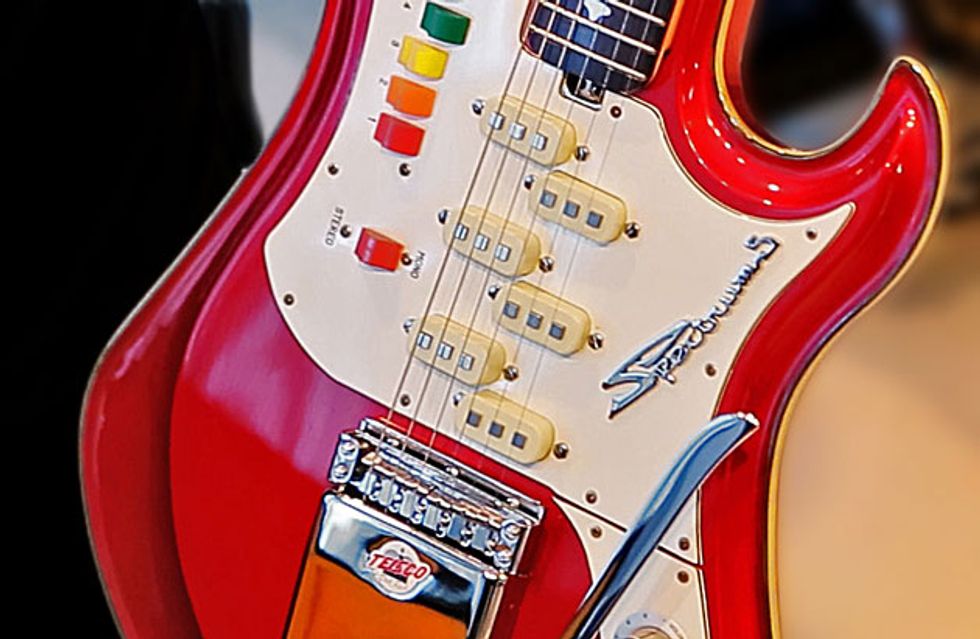The Teisco Del Rey Spectrum 5 that made its debut in the mid ’60s is a fine example of pushing the landscape limit on a guitar’s face with onboard controls.
What’s the main factor a guitarist considers when selecting an instrument? Tone? Playability? Comfort? It’s usually a combination of all these things (coupled with price and a healthy dose of image). But have you ever bought a guitar you were in love with, only to find that the controls drove you crazy? Many of us have put up with confusing switches or clumsy control positioning and forgiven an axe’s ergonomic shortcomings because everything else was great. Have you ever wondered how something like knob position is decided?
Even the first electrified guitars from the early 1930s—the Ro-Pat-In “Frying Pan” and Lloyd Loar’s Vivatone—featured onboard controls to adjust the instrument’s sound. Although the dynamics of performance was still available to the player via hand technique, the builders of those early guitars sought to provide the musician with an electronic method of managing all that raw power.
At first it was only a single volume-control knob, but a tone control soon joined the party on the face of the electric guitar. Both of these contrivances were probably added as mimicry of the radio technology on which the guitar and amplifier rig was based—yet they endure pretty much unchanged today. Positioning was simple (usually near the bridge where the guitarist could get to them quickly) and for a few years, that was fine.
But soon, the never-ending quest for more resulted in additional stuff being added. Guitars sprouted secondary pickups with switches and knobs to control them. Later, three and even four pickups appeared on guitars that were accompanied by a smorgasbord of toggles, sliders, pushbuttons, and knobs to dial in dozens of combinations. Some of the sounds were good, but others not so much. The important thing was that a guitar salesman could point to features. It was the era of Sputnik and the arms race between nations, which was seemingly echoed in the designs of electric guitars. It was a time when more was perceived as better.
Whereas the simple one-volume/one-tone setup allowed a designer to place everything close at hand, priorities had to be established as a sort of urban congestion filled up the face of guitars. To complicate things further, instruments began to feature vibrato tailpieces with arms that invaded the airspace above the controls and sometimes made their placement difficult.
The saving grace in the early days was that a guitarist’s routine was usually split between two modes: playing chordal rhythm and taking a solo. As long as the guitar could be toggled between two preset sounds, everything was fine. This was most famously tried on Fender’s Jazzmaster and its two parallel sets of controls that could be preset, presumably for lead or rhythm work.
Of course, guitarists are never satisfied with only a few choices. As guitar sounds began to dominate live music, it became more important for a player to be able to manipulate and modify an instrument’s sound on the fly. We do this today with the help of complex pedalboards, but at first (aside from the much fewer available effects at the time), it was more about the guitar’s controls. A high point of complexity may have been the 1978 B.C. Rich Bich that boasted an entire electronics bin of mini switches bristling from its top.
In a return to the early days, however, the basic layout of the electric guitar eventually became more standardized with a simple pickup selector and the volume control close to the musician’s picking hand. The Stratocaster should win the award for this, as its volume knob resides a mere .75" from the 1st string. If your technique includes doing volume swells, the placement is magnificent. But some guitarists find that they inadvertently slap the volume while strumming. Similarly, the Strat’s pickup selector is angled directly along the natural sweep of the picking hand. Some find it handy, but others are constantly moving it accidentally.
The Les Paul design houses the control knobs at a further distance from the strings (probably because this was the way Gibson has always done things and because the controls need a flat area away from the arch of the top). PRS approached this design challenge by routing large holes in the top where the controls were located. PRS also first utilized rotary switching because blade-type switches were designed for thin plates like Fender uses, not thick wood tops. Builders must always be careful when adapting a blade switch to a guitar top by keeping the slot angled across the grain and not parallel, which can cause splitting over time.
For every design decision, there are fans and detractors. For me, the Les Paul pickup selector is always in the way, yet others find it perfect. Lots of Tele players turn the control plate around backwards, and swap the volume and tone to keep the toggle out of the way and bring the volume knob closer. Some players use a volume pedal and forsake the onboard controls completely. You can’t please everyone, so you’ve got to decide what’s important and please yourself. Thankfully, we’re in an era where there are quite a number of alternatives.








![Rig Rundown: Russian Circles’ Mike Sullivan [2025]](https://www.premierguitar.com/media-library/youtube.jpg?id=62303631&width=1245&height=700&quality=70&coordinates=0%2C0%2C0%2C0)

















